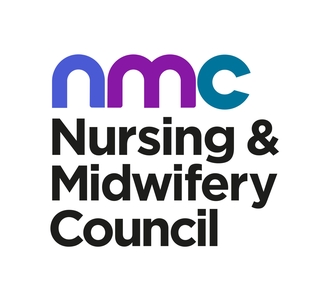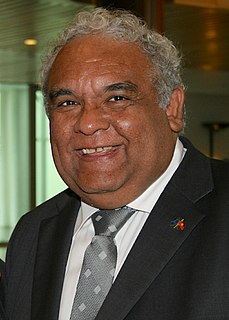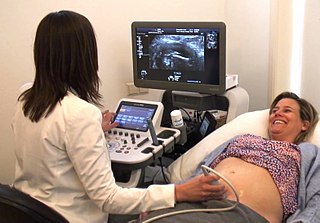
Torres Strait Islanders are the Indigenous peoples of the Torres Strait Islands, which are part of the state of Queensland, Australia. Ethnically distinct from the Aboriginal people of the rest of Australia, they are often grouped with them as Indigenous Australians. Today there are many more Torres Strait Islander people living in mainland Australia than on the Islands.

The Nursing and Midwifery Council (NMC) is the regulator for nursing and midwifery professions in the UK. The NMC maintains a register of all nurses, midwives and specialist community public health nurses and nursing associates eligible to practise within the UK. It sets and reviews standards for their education, training, conduct and performance. The NMC also investigates allegations of impaired fitness to practise.

The Australian Nursing and Midwifery Federation (ANMF) is the largest union in Australia, with 274,956 members in 2018. The union is run by nurses, midwives and assistants in nursing to advance the industrial, political and professional interests of its members.

Aboriginal Australians are the various Indigenous peoples of the Australian mainland and many of its islands, such as Tasmania, Fraser Island, Hinchinbrook Island, the Tiwi Islands and Groote Eylandt, but excluding the Torres Strait Islands. Aboriginal Australians comprise many distinct peoples who have developed across Australia for over 50,000 years. These peoples have a broadly shared, though complex, genetic history, but it is only in the last two hundred years that they have been defined and started to self-identify as a single group. The definition of the term "Aboriginal" has changed over time and place, with the importance of family lineage, self-identification and community acceptance all being of varying importance.
Aboriginal self-determination refers to the governance and decision-making power of Aboriginal and Torres Strait Islander peoples. It is the right of Aboriginal and Torres Strait Islander peoples to determine their own political status and pursue their own economic, social and cultural interests. Self-determination asserts that Aboriginal and Torres Strait Islander peoples should direct and implement Aboriginal and Torres Strait Islander policy formulation and provision of services. Self-determination encompasses both Aboriginal land rights and self-governance.
Indigenous Australians are people who are descended from groups that lived in Australia and surrounding islands before British colonisation. They include the Aboriginal and Torres Strait Islander peoples of Australia. The term Aboriginal and Torres Strait Islander people is preferred by many; First Nations of Australia, First Peoples of Australia and First Australians are also increasingly common terms.

The Rural Health Education Foundation is an Australian provider of television-based health education for doctors, pharmacists, nurses and allied health professionals.
The National Rural Health Alliance (NRHA) is Australia's peak non-government organisation for rural and remote health.
The Australian Indigenous HealthInfoNet is an internet resource that collects, collates and interprets evidence-derived knowledge on Australian Indigenous health. It then makes this knowledge readily accessible via the internet to inform policy, practice, research, teaching and general community understanding. Its purpose in doing this is to contribute to improving the health of Indigenous Australians.
Indigenous health in Australia examines health and wellbeing indicators of Indigenous Australians compared with the rest of the population. Statistics indicate that Aboriginal Australians and Torres Strait Islanders are much less healthy than other Australians. Various government strategies have been put into place to try to remediate the problem; there has been some improvement in several areas, but statistics between Indigenous Australians and the rest of the Australian population still show unacceptable levels of difference.

Thomas Edwin Calma, in Darwin, Northern Territory an Australian Aboriginal elder of the Kungarakan people and member of the Iwaidja tribal group whose traditional lands are south west of Darwin and on the Cobourg Peninsula in the Northern Territory respectively, a human rights and social justice campaigner. He is the sixth Chancellor of the University of Canberra, a post held since January 2014. Calma is the second Aboriginal or Torres Strait Islander person to hold the position of Chancellor of any Australian university. The first was Pat O'Shane AM who was chancellor of the University of New England (Australia) from 1994 to 2003.

A midwife is a health professional who cares for mothers and newborns around childbirth, a specialization known as midwifery.
The Closing the Gap framework is an Australian government strategy that aims to reduce disadvantage among Aboriginal and Torres Strait Islander people, based on seven targets. From adoption in 2008, after meetings with the Close the Gap social justice campaign, until 2018, the federal and state and territory governments, worked together via the Council of Australian Governments (COAG) on the framework, with the Department of the Prime Minister and Cabinet producing a report at the end of each year analysing progress on each of its seven targets.
Midwives in South Africa are nurses who focus on the care of pregnant women and the delivery of babies. Midwives have the ability to work independently in cases of healthy pregnancies and problem-free deliveries; however, they can refer patients to gynaecologists or obstetricians when complications are diagnosed. The majority of pregnant women in South Africa use the public healthcare system, and most of this care is provided by midwives.
Sally Sophia Goold is a Wiradjuri woman who became the first Aboriginal nurse in New South Wales, Australia. Goold was awarded the Medal of the Order of Australia on 1986 and named the Senior Australian of the Year in 2006.

MaryAnn Bin-Sallik is Djaru Elder and Australian academic, specialising in Indigenous studies and culture. She was the first Indigenous Australian to gain a doctorate from Harvard University.
Pat Anderson is an Australian human rights advocate and health administrator, an Alyawarre woman from the Northern Territory, she is well known internationally as a social justice advocate, advocating for improved health, and educational and protection outcomes for Aboriginal children.
Lisa Rae Jackson Pulver is an Aboriginal Australian epidemiologist and researcher in the area of Aboriginal health who has been Deputy Vice Chancellor at the University of Sydney since October 2018.
Donna Hartz is an Aboriginal Australian midwife, academic and member of the Kamilaroi peoples of north eastern New South Wales. She grew up in the western suburbs of Sydney.







